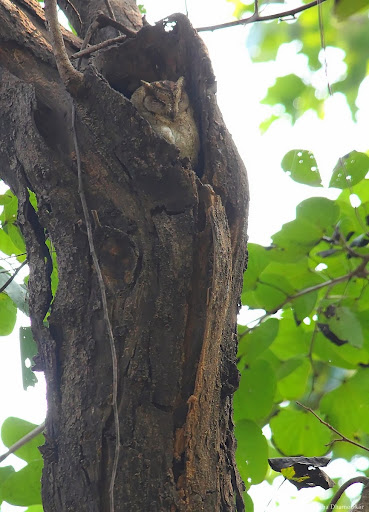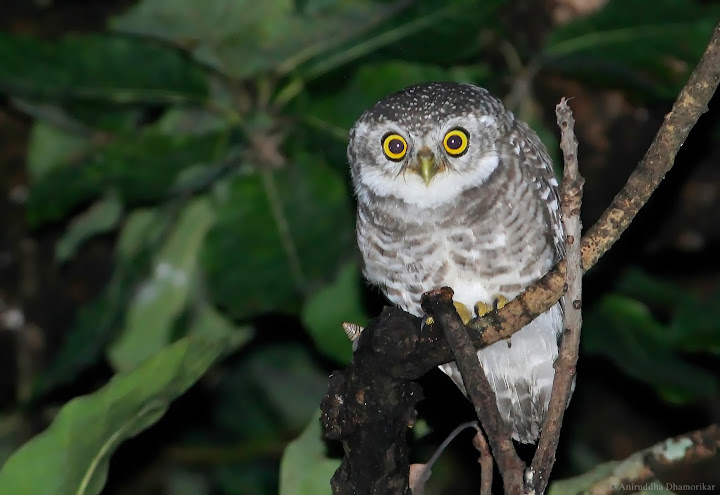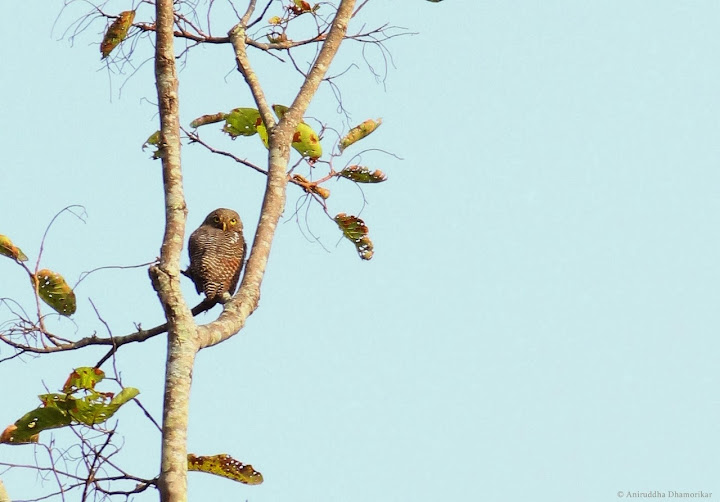Thing About Owls
There is certain intelligence to
animals that can captivate you with their gaze. Owls happen to be one of them. Those
who have seen an owl have been enchanted by their gaze forever. Hardly anyone ever
forgets seeing their first owl. I’ve mostly seen them in their natural habitats–
where they belong – blissfully sitting still in the afternoon sun only to
become active during dark, and unfortunately, I’ve seen them where they don’t.
The ruckus of Jungle Owlets, a he-owl calling a she-owl, is
omnipresent where I live. It is also the most pleasurable to hear, and mystic.
Then there are the Spotted Owlets, the phantoms of the night, with their large
bulbous eyes they look at you in perseverance. They sit by the streetlights at
night and in their wooden caverns by day. And there are Collared Scops Owls,
the fairies of the dark, with their cautious deep dark eyes and tufts of horns,
sprinting from branch to branch. All of them, in the day, would be solemnly
sitting in their respective abodes – setting up homes and bringing up families
at the edge of human settlements.
| Living under the shingled roof of an old school, this pair of Spotted Owlets (Athene brama) is known to all the people in the village, and have let them live unharmed so far. |
The first of my discovery of owls was
in my childhood when a large (larger then) Barn Owl entered our premises and
sent every one of my friends home in terror. By luck or fate, the owl entered
our neighbour’s home, and I remember his eyes, with a gaze that passed right
through me. We let it rest there until sun down. On another occasion, another
Barn Owl was found exhausted and terrorized by crows, which after a peaceful
few hours of twilight recovered and flew off at night. People have, on both
these occasions, called them a bad omen – for me they were the dark knight of
the cities, flying silently from one side of the street to another. What’s so daunting
about them that makes one want to have them killed, or in magic pots, and as
exotic pets?
 |
| The Collared Scops Owl (Otus lettia), rely more on camouflage than fleeing, and sit by their tree hollows during day-time |
At the end of the night as new day’s light casts a blue sky,
they return – they always return – to their habitual abodes – mostly hollows in
old-growth trees or trees with dense foliage. Some have spent generations just
beyond the reach of man – but not all who know where they dwell are friendly.
 |
| Poachers intending to sell off owls for black magic purposes usually break a wing - as can be seen on this Collared Scops Owl fledgling rescued from hunters and being treated by a vet |
A wing is usually broken first when they are captured – so
that they will never be able to fly. Two bones – the radius-ulna, cleanly
sliced. Then they are bagged and transported either to an underground market or
to a house, always ending up on an altar or in a soup. Some are brought up to
be sold to those blind owl-lovers who prefer a Hedwig in a cage than an owl
free to fly through the night sky. Ahmed, in his TRAFFIC report “Imperilled
Custodians of the Night – a study on illegal trade, trapping and use of owls in
India”, recorded 13 of 30 species in demand primarily for black magic purposes,
albeit legal protection to all the Strigiformes (Schedule IV) under the
Wildlife Protection Act of 1972. He says:
“Despite the fact that owls were generally not openly displayed or advertised, it was apparent that their trade was reasonably widespread. One possibility is that recent clampdowns on the trade in domesticated birds is causing traditional bird traders and trappers to shift back to trading in wild birds which have a higher value. Owls fit the bill perfectly: due to the sheer number of superstitions and traditions surrounding them within India they are always in demand and, consequently, attract a high premium. Indeed, prices for traded owls have only risen considerably since 2002.”
I discovered a little fraction of
this trade in January when a colleague of mine rescued a pair of Collared Scops
Owl from the clutches of villagers in the forests of Central India. Their
wing-bones had been clearly broken. In Abrar Ahmed’s report, Collared Scops Owl
ranked fifth in the frequency of occurrence of Indian owl species observed in
trade (pp. 18), preceded by Jungle Owlet, Rock Eagle-owl, Barn Owl, and, the
most hunted, Spotted Owlet.
 |
| Night, especially on a full moon, are a time black magicians recommend sacrifice of owls - albeit their legal protection under the Wildlife Protection Act of 1972. |
Although superstitions and traditions
are sternly believed and followed in remote communities for generations –
probably dating back to several decades or possibly centuries, the blame put
upon them for hunting and marketing is justified by the fact that most, if not
all, know the ramifications of hunting wildlife in today’s times. It is
therefore a serious crime not only because it is saturated with dark
superstitions but also because it is the least undocumented underground
trade-networks benefitting from these superstitions.
 |
| Rescued from the clutches of hunters, I can't help but see pity in the eyes of this owl - pity for mankind |
The two owls which could have ended
up in a broth of mysticism constitute an insignificant number of owls and other
birds hunted for black magic, but they were the victims of it nonetheless.
During the course of days we discovered that one of the owls was a fledgling,
while the other was an adult, probably the mother, who later lived to see the stars
above her head and wind under her wing. Over the period, though, I learnt a
great deal about owls, about their mellow, peaceful, yet wild, nature. Over the
days I grew fond of them both – it was more than pity towards them. I did not
want them to merely survive although I debated against the fact that life is
valuable, but it is valuable only when it is allowed to live on its own terms. Under
the guidance of experts and friends, medicating and feeding them became our
priority.
Madhya Pradesh is one of the
principal Indian states where actual trapping of owls is organized, ranking
second to Uttar Pradesh (Ahmed, 2010). This could be because a number of tribal
communities living in the area are traditional hunters, which have now seen the
flair of economy that hunting brings to them. The grimness of this situation is probably
best described by Ahmed, “Sometimes
Spotted Owlets were dyed (with tea-leaf water, Acacia catechu extracts, or
lamp-black mixed with mustard oil) and feathers struck with latex to the head
to make the bird appear horned. Red colouring was also sometimes inserted into
their eyes to alter their yellow eye colour so that they appeared like the
larger horned owl species.” (Pp. 20).
 |
| The most common owl of India, the Spotted Owlet ranks first amongst the most exploited owl species in India. |
The TRAFFIC report clearly details
the magnitude of the trade of owls in India, but also the desperate attempts
made in order to make quick money. What lies in the centre of this activity is
the demand for owls. When a living being is price-tagged, it is done so to lure
customers who can afford to pay the price. In context of owls, which are sold in
a range of Rs 200 to Rs 4000 (Ahmed, 2010, pp. 38), the customers primarily
come not from the hunting tribes but from well-to-do families wrapped in false
beliefs, superstitions, and, disturbingly, infatuation.
 |
| If it is their charm that makes people want to keep owls as pets, it is also their curse. Owls are wild and hard to tame, keeping them, or any wild animal, as pet is cruel and inhuman |
An article in BBC talked about an
increase in people in India demanding to buy owls irrespective of their legal
protection. Mr Jairam Ramesh, the then
Minister of Ministry of Environment and Forests, blamed “fans of boy wizard
Harry Potter” for their role in the dwindling number of wild owls, quotes the article
published in November 2010. Probably the most infuriating quotes from Harry
Potter series, albeit its innocent intention is, “Harry now carried a large
cage that held a beautiful snowy owl, fast asleep with her head under her wing.” - Harry Potter and the
Philosopher’s Stone.
| A Brown Fish Owl (Ketupa zeylonensis) looking through thick foliage in a Sacred Grove - some of the oldest community-protected forests areas of India which also act as a safe haven for wildlife |
Curiously, and equally disturbingly, Huffington
Post in May 2012 highlighted an increase in abandoned pet owls in animal
sanctuaries in England, saying, “Harry Potter fans enchanted with the boy
wizard’s owl sidekick Hedwig drove up demand for the birds during book and
movie releases […] now that all book installments and film adaptations have
been released, many owners are abandoning their pet owls into the wild, where
they are unprepared to care for themselves.” What’s endearing is that the
author J. K. Rowling made strong pleas to fans to discourage keeping owls as
pets.
| Owls generally use their piercing gaze and puff their feathers to intimidate an opponent, as displayed by this Brown Fish Owl. |
In Indian mythology, owl is the
vehicle of Goddess Lakshmi (the Goddess of wealth). According to the TRFFIC report, they are most
sought-after ahead of Diwali for ritual purposes, and is traditionally sacrificed
on auspicious occasions, or to become prosperous through heinous ways. From the
eyes to the claws, almost all the parts are consumed in bizarre rituals. Today,
law is the only means to curb this menace, for stopping people from believing
in superstitions will require a cultural shift and a change in attitudes which
will take several human-generations to realize.
 |
| One of the small members of the Scops group, an Oriental Scops Owl (Otus sunia) is an active hunter of insects |
I often feel exhilarated to sight an
owl on a nature trail. With their supreme camouflage and stealthy behaviour,
they have evolved over millions of years to become perfectly still and silent.
To seek them in their natural surrounding is therefore a challenge. Yet if you
sit quietly on the nights, you will be able to hear the conversations that owls
have. Whether it’s a hoot, a whoop, an eerie tune or a ghoulish scream, owls
are expressive in the cover of the night and a delight to listen to.
Now when I think about the Scops, I
wonder what they would have to say about mankind. I’m certain that they hate
humans for more valid reasons than mere superstitions for one. What I intended
to do was to undo what my species did to theirs, but somewhere I failed, for
the Scops would never live the same life she led, even when today she is a free
owl. What they would say about mankind would be too embarrassing to talk about
any species. I learnt it by listening to her threatening hiss and snarls… that
she did not like what was happening around her. But we respected that, for the
intention was never to tame her but to set her free.
 |
| Jungle Owlet (Glaucidium radiatum) is a rather vocal species of owl that can be seen quite commonly during day-time |
The owls are in danger. There’s
probably not a great deal that many of us can do, except by being aware of this
other thing about owls, the fact that
they are hated (or prized) for ridiculous reasons, amongst things which have
made owls our favourites.
I would recommend you to read the detailed report
published by TRAFFIC on the illegal owl trade in India; to keep an eye out on
any owl residences in your area; and to record and inform the authorities and
wildlife rescue NGOs (especially the latter) if you find captured owls or a
person keeping pet owls.
| An owl being an owl - Collared Scops Owl preening itself |
The pleasure should be in letting an
owl be an owl, and an owl is an owl only when it is free.
Superb blog. Very informative. Keep it up Annirudh
ReplyDeleteTo the point of infinity - Why have your posts become so infrequent?
ReplyDeleteTo the point of infinity - I love the 5th pic. Is it taken by you? The photographer's clear reflection in the curious eyes make this pic so different.
ReplyDeleteThank you, to the point of infinity. Yes, it was a rescuee staying with us for a while. Field work doesn't allow for much time to write, but I'm trying to squeeze out some during holidays - thank you for reading :)
Delete